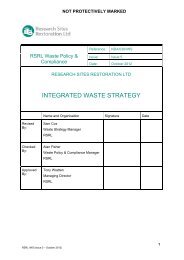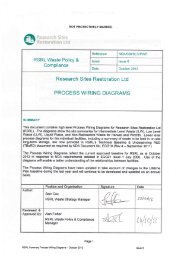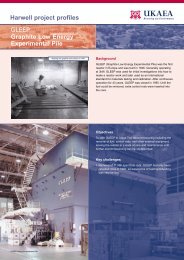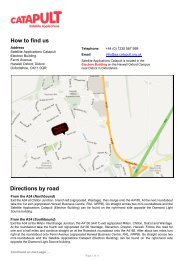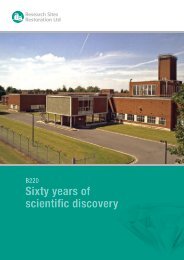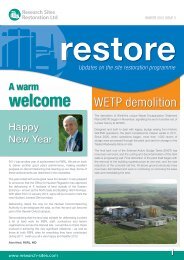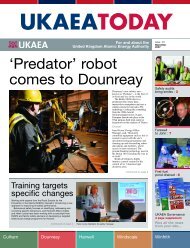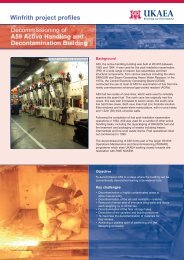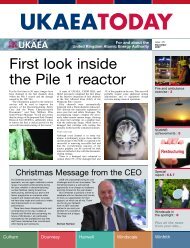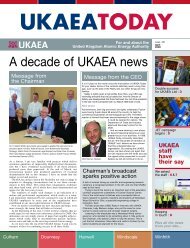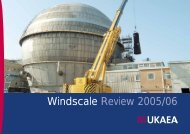Harwell Evolution Brochure - Research Sites Restoration Ltd
Harwell Evolution Brochure - Research Sites Restoration Ltd
Harwell Evolution Brochure - Research Sites Restoration Ltd
- No tags were found...
Create successful ePaper yourself
Turn your PDF publications into a flip-book with our unique Google optimized e-Paper software.
<strong>Evolution</strong> of UKAEA <strong>Harwell</strong>
DecommissioningWhen a nuclear facility has finished its operational programmeit has to be dismantled safely and any radioactive materialscarefully packaged and sent for disposal or long term storage.Most of the radioactive materials are removed at an earlystage. Subsequent dismantling of the plant and equipment iscarried out in stages.When all the plant and equipment has been removed the mainbuilding structure is checked and any residual radioactivityremoved prior to building demolition. Substantialdecommissioning work has been carried out at <strong>Harwell</strong> since1990. Some examples are briefly described below.Many buildings have already been removed from the <strong>Harwell</strong>site. In the next few years more facilities will bedecommissioned including the GLEEP research reactor, andtwo large former RAF aircraft hangars which have housedexperimental facilities. Work will start on the decommissioningof the B220 active handling building and many buildings usedfor handling lower levels of radioactivity will be demolished.• The LIDO research reactor has been completely removed.• The DIDO and PLUTO research reactors have beendefueled and all the peripheral and support equipmentremoved. They are now in a state where they can safelybe left in care and maintenance for about 40 years. Thiswill allow some of the relatively short lived radioactivity (e.g.60 Co) to decay which will allow the final decommissioningto be carried out using relatively simple equipment.Active handling building in operation• A large number of plutonium active glove boxes in B220have been dismantled. Robotic technology was used formuch of this work.• Lead shielded cells used for examination of irradiated fueland reactor materials have been dismantled.• A large seven storey chemical engineering developmentbuilding has been completely demolished.Active handling building following decommissioning of shielded cellsLow level waste for disposalRadioactive wastemanagementDifferent types of radioactive waste are produced on the site.Ventilation of buildings to allow safe working results in thedischarge of tiny quantities of radioactivity to the atmosphere.Liquid wastes are treated to reduce the radioactive content tovery low levels before discharge. A plant has been built tocement sludge wastes. The decommissioning work generatessolid radioactive waste (e.g. redundant plant and equipment)and there are wastes from past research and developmentwork, which have been stored on the site. Over 95% of thesolid radioactive wastes are in the low-level waste category,which are sent for disposal at Drigg in Cumbria. The moreradioactive intermediate level waste is held in long termstorage until a deep underground repository is available. Thereare no high level radioactive wastes at <strong>Harwell</strong>.In recent years there has been considerable investment in newradioactive waste stores and there is an ongoing programmeof recovering the waste from the old stores and repacking forlong term storage. In the next few years there will be improvedwaste recovery equipment and new buildings for cementationof the wastes constructed.Intermediate level waste store3
Land remediationA programme of work is underway to survey the land at<strong>Harwell</strong> for any contamination from chemicals andradioactivity. Like many sites, which have been in industrialuse, there are some areas which have been subject tocontamination. Through the survey programme suspectareas are identified, investigated and remediated asappropriate. There are some areas of the site, which havebeen used for disposal of chemicals, beryllium, and lowlevels of radioactivity. In particular a major remediation of aseven-hectare area, known as the Southern Storage Area,has been completed. Known chemical and berylliumdisposal pits have been removed and all the land checkedand proven to be clean. During the work munitions arisingfrom the RAF use of the site were also removed.Further chemical disposal pits in what is known as theWestern Storage Area will be removed. These pits wereused for the disposal of chemicals including chlorinatedhydrocarbons, which have entered the groundwater belowthe site. A “pump and treat” plant is in operation to recoverchlorinated hydrocarbons from the aquifer and prevent anyfurther spread of contamination.Plant for removal of chlorinated hydrocarbons from groundwaterAs the decommissioning work on the nuclear licensed siteprogresses the land and buildings are being thoroughlysurveyed to ensure that there is no residual radioactivity.This will allow a substantial part of the eastern end of thesite to be delicensed (i.e removed from the controls of thenuclear site licence) and the land made available for otheruses.Beryllium disposal pit after removal of waste showing clay linerMajor new site utilities installedin 2003Property managementThe land and buildings owned by UKAEA form part of the<strong>Harwell</strong> Chilton Campus. Together with the separate freeholdsof Rutherford Appleton Laboratory and National RadiologicalProtection Board the campus is a major centre for employmentwith around 4000 people working here. Many of the existingbuildings on the site are made available by UKAEA to tenantorganisations. A number of these organisations were spun offfrom UKAEA and new businesses are being attracted to thesite. There is an Innovation Centre designed for start-upbusinesses and a range of other businesses have moved to<strong>Harwell</strong>. The Medical <strong>Research</strong> Council is expanding andbuilding the Mary Lyon Centre to support the Genome project.A major new facility called the Diamond Light Source is beingbuilt adjacent to the Rutherford Appleton Laboratory, fundedby Government and the Wellcome Trust.The Diamond Light Source will have many applications but willbe particularly suitable for the examination of the structure ofbiological materials. In the past <strong>Harwell</strong> has been associatedwith nuclear research and development but the newdevelopments around the campus will place it at the forefrontof bioscience research. The scale and reputation of thecampus means it is well placed for further new development.<strong>Evolution</strong> of UKAEA <strong>Harwell</strong> 4
Artist’s impression of Diamond light source faciltyCourtesy of JacobsGIBB <strong>Ltd</strong>/Crispin Wride Architectural Design StudioMary Lyon Centre under construction 2002The futureSubstantial progress has been madeon the environmental restorationprogramme at <strong>Harwell</strong>. A smallernuclear site will remain for some yearsuntil all the decommissioning iscomplete and it is possible to disposeof the remaining radioactive wastes.The reduction of the nuclear site isallowing new development around the<strong>Harwell</strong> campus, which will ensure thatit continues to grow as a major centrefor science and technology. What wasAERE is now known as <strong>Harwell</strong>International Business Centre.New software engineering buiding completed in 2000<strong>Evolution</strong> of UKAEA <strong>Harwell</strong> 5
Stages in site restorationFor further information, contact Nick Hance Tel: 01235 436909UKAEA Marshall Building 521 Downs Way <strong>Harwell</strong> Didcot Oxfordshire OX11 0RAvisit us at www.ukaea.org.uk



